We've come a Long Way, Baby!
by Tim Robinson, 2006
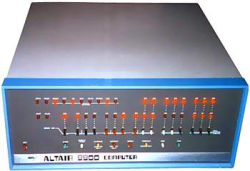
I didn't get in on the development of the very first personal computers; I came on board about the time of the Radio Shack (Tandy) TRS-80. Recently, I've been reminded of those times and thought that many of our readers might not have been fortunate enough to have experienced the early days of personal computing. For some of you, this will be memory lane, while for others it may be insight into the greatest technological development period in mankind's history.
I will not try to define exactly what a personal computer is, or identify which was the first personal computer. There are as many answers to those questions as there are people pondering them. I'll jump in with a few names and dates from what most people would consider the origins of practical personal computers and we'll go from there.
Here's a basic description of what a device must be to be called a personal computer: It must be a digital computer. It must be largely automatic. It must be programmable by the end-user. It must be accessible, either as a commercially manufactured product, as a commercially available kit, or as widely published kit plans. It must be small enough to be practical to set up by theaverage person. It must be inexpensive enough to be affordable by the average professional. It must be simple enough to use that it requires no special training beyond an instruction manual. MITS Altair 1975.
This unit was introduced in January, 1975 as a construction project in Popular Electronics Magazine. And far as I can determine it was the first 8080 based microcomputer. Although the Altair was not the first available microcomputer, it started the industry on that long road to today's machines.
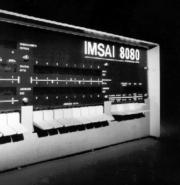
Imsai 8080. Developed by Imsai Associates it used the same I/O bus structure as the MITS Altair, later known as the S-100 bus. Imsai spent time studying the Altair and identified many physical limitations in case design and component layout, especially as it related to expansion, and then designed their product to eliminate them. Shortly, the Imsai 8080 became a major force in the early days of personal computing.
South West Technical Products Company M6800. About the time Imsai was making major progress with their personal computers, South West Technical Products produced the M6800, a Motorola 6800-based computer. They created their own buss, the SS-50, and provided a full range of peripheral kits. Remember, these were kit computers, so anything that made them easier to build or more reliable later was a definite plus. The SS-50 buss had only 50 pins which were spaced wider than the 100 pins of the S-100 bus. This made soldering in connectors and such much easier.
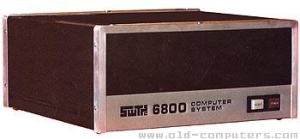
All this time, personal computers had front panels with switches for entering the bootstrap programs, used teletypewriters and paper tape for data storage and entry. Keyboards as we know them were just beginning to make their appearance. Many were uppercase only. It was possible with the M6800 to connect a video terminal board and a television monitor. There were other computers available with similar designs and capabilities during this time. Most had anywhere from 2K to 16K of memory and no operating system as we understand that term today.
Everything was done in machine language, though there were assembler programs written that made it possible to create your application by entering source code (after manually flipping switches to enter the bootloader). The source code was then converted into machine language which one then saved to paper tape for use later. Things were about to change.
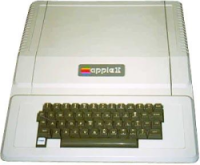
Apple Computers Apple II. Introduced in 1977, the Apple II is probably deserving of the name "the first personal computer". The Apple II caused a major revolution in this new industry. Not a kit, but a factory built unit, it came "ready to use". An extensive list of software and with a low-cost floppy disk system, the Apple II introduced the public to the idea of real graphics and color. It came with a modem that made it possible to connect to other computers. When Visicalc, a spreadsheet debuted, the Apple II suddenly became a staple in the business world. I'm not sure, but the Apple II may have been the first personal computer to offer a video monitor as standard.
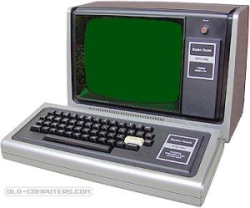
Radio Shack (Tandy) TRS-80. The Radio Shack TRS-80 hit my city in late 1977, and I wound up with the first one sold there. The TRS-80 was an immediate sensation. It came with the complete computer inside a slightly enlarged keyboard case, a 12 inch black and white monitor, 4K Basic in ROM and 4k RAM. The CPU was initially an Intel 8080 running at 800KHz. Radio Shack quickly upgraded to an 8080 at 1.6MHZ, and then to a Zilog Z80, which offered improved performance at the same clock speed. For data and program storage, there was an optional slightly modified audio tape cassette machine and special high quality tapes.
Unlike the Apple and other computers of that time that offered 80 character by 24 line displays, TRS-80s offered 64x16, and the first version, dubbed Model One, was uppercase only. In spite of its limitations compared to the concurrent Apple II, the TRS-80 was an instant success. Part of that success was the low price (less than $500 USD), but the ubiquity of Radio Shack stores also contributed. Over the following years, the TRS-80 grew in capability and the physical design improved. But the handwriting was on the wall. A giant was getting organized.

Atari Model 400 & Model 800. For many years (some will even suggest up to the present), Atari held a major place in the computer gaming arena. They had arguably the best graphics and were fast for that era. Unfortunately, the Model 400 had a less than stellar keyboard (membrane, rather than full-motion). The Atari machines were based on Motorola 6502 CPUs at a time when Intel and Zilog were blitzing the market with the 8080 and Z80. Because of Atari's restrictive policies regarding secrets necessary for programming their machines, there was not the same development of applications as for the other branch of the CPU tree.
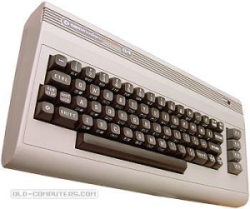
Commodore 64. Approximately 1981, Commodore, who previously had marketed the Pet (Europe and UK, later to schools in the U.S.) and the Vic-20, introduced the single unit Commodore 64. It had 16 colors in place of the eight on the VIC-20. The video display was 40-columns wide. There was a built-in music synthesizer chip and Commodore introduced simple graphics called Sprites. Unlike most other machines of that era, it had 64K of RAM; Apple then had a maximum of 48K. Initially it sold for $595 (USD), and soon appeared at K-mart for $400. There were many other personal computers than those I've mentioned during this period, too many to list. Each introduced some new or better way of operating or improved the physical aspects of designs. It was a time of great activity. But a giant was on the horizon: IBM.
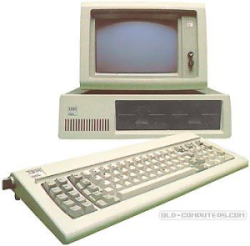
The IBM PC. All during the years I've described above, IBM was quietly watching. It has been said that IBM stands for "I Believe in Money". Probably not, but they were and are not stupid. They knew the handwriting was on the wall for mini and mainframe computers. Oh, there would always be a market, but the public was eating up these new microcomputers.
IBM would not be left out. In 1981 they implemented "Project Chess" and the initial plans of the first IBM personal computer were laid. Development was swift with the initial release of the new machine on August 12, 1981. IBM named it the IBM PC, which stood for personal computer, and hence they are responsible for popularizing the term PC.
The first PC ran an Intel 8088 CPU at 4.77 MHZ, came with 16KB of memory and could be expanded to 256KB, a huge amount at that time. The machine came with one or two 160KB floppy drives and a color monitor was optional. IBM made the decision to use off the shelf components, resulting in an open architecture system. Had they decided to keep their designs proprietary, the PC as we know it today might never have happened. Less than four months after the introduction of the IBM PC, it was named "Man of the Year" by Time Magazine.